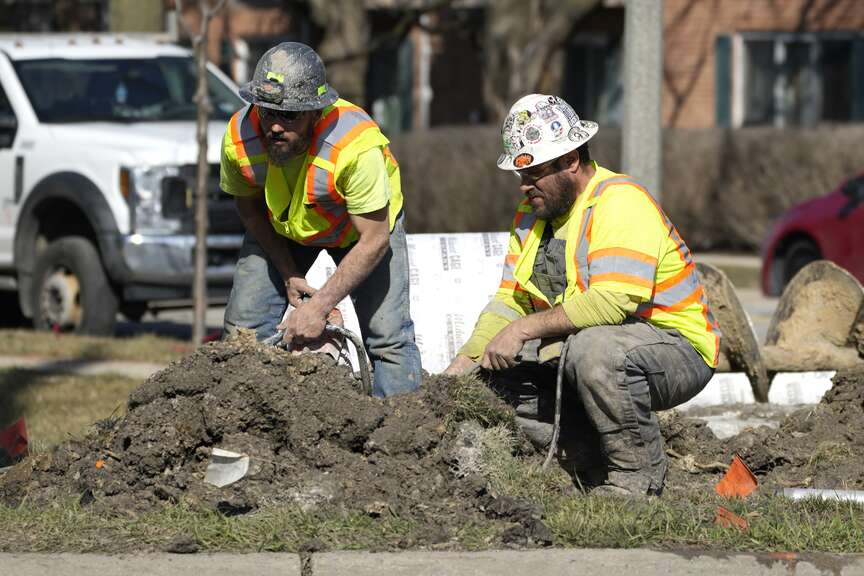WASHINGTON -- America's employers delivered another outpouring of jobs in March, adding 303,000 workers to their payrolls and bolstering hopes that the economy can survive inflation without succumbing to a recession in the face of high interest rates.
Last month's job growth was up from a revised 270,000 in February and was far above the 200,000 jobs that economists had forecast. By any measure, it amounted to a major burst of hiring, and it reflected the economy's ability to withstand the pressure of high borrowing costs resulting from the Federal Reserve's interest rate increases. With the nation's consumers continuing to spend, many employers have kept hiring to meet steady customer demand.
"The vanishingly few areas to criticize this labor market are melting away," said Andrew Flowers, chief labor economist at Appcast, a recruitment advertising firm.
Friday's report from the Labor Department showed that the unemployment rate dipped from 3.9% to 3.8%. The unemployment rate has now remained below 4% for 26 straight months, the longest such streak since the 1960s. The government also revised up its estimate of job growth in January and February by a combined 22,000.
Normally, such an addition of new jobs would raise concerns that a vibrant labor market would force companies to sharply raise pay to attract and keep workers, thereby fanning inflation pressures. But the March jobs report showed that wage growth was mild last month, which might allay any such fears. Average hourly wages were up 4.1% from a year earlier, the smallest year-over-year increase since mid-2021. From February to March, though, hourly pay did rise 0.3% after increasing 0.2% the month before.
The "continued vigor," said Joe Davis, global chief economist at Vanguard, has come from "household balance sheets bolstered by pandemic-related fiscal policy and a virtuous cycle where job growth, wages and consumption fuel one another."
The economy is sure to weigh on Americans' minds as the November presidential vote nears and they assess President Joe Biden's reelection bid. Many people still feel squeezed by the inflation surge that started in the spring of 2021. Eleven rate increases by the Fed have helped send inflation tumbling from its peak. But average prices are still about 18% higher than they were in February 2021 -- a fact for which Biden might pay a political price.
In a statement Friday, though, Biden argued that the economy's strong performance means that his policies are paying off.
"My plan is growing the economy from the middle out and the bottom up, investing in all Americans and giving the middle class a fair shot," he said. "Inflation has come down significantly. We've come a long way, but I won't stop fighting for hard-working families."
The 303,000 jobs that the economy added in March were the largest gain since last May. And they increased average monthly job growth so far this year to a vigorous 276,000, an improvement even on 2023's robust average of 251,000.
The unemployment rate fell last month even though a sizable 469,000 people entered the labor force looking for work. That influx increased the proportion of Americans who either have a job or are looking for one from 62.5% in February to 62.7%. A bigger labor force tends to ease pressure on companies to significantly raise wages, thereby slowing inflation pressures.
Though most industries added jobs last month, hiring was mainly concentrated in three categories: Health care and private education, leisure and hospitality and government accounted for nearly 69% of the hiring. In addition, construction companies added a solid 39,000 jobs.
Four years after the pandemic curbed travel and forced shutdowns of restaurants, bars and entertainment venues, those industries have finally regained their pre-pandemic employment level, with a category that includes such businesses adding 49,000 jobs in March.
The Fed's policymakers are tracking the state of the economy, the job market and inflation to determine when to begin cutting interest rates from their multi-decade highs. Rate cuts by the Fed would likely lead, over time, to lower borrowing rates across the economy.
"The U.S. labor market appears to be strengthening, not slowing, and risks delaying Fed easing," Sal Guatieri, senior economist at BMO Capital Markets, said in a note.
The central bank's policymakers started raising rates two years ago to try to tame inflation, which by mid-2022 was running at a four-decade high. Those rate increases -- 11 of them from March 2022 through July 2023 -- helped drastically slow inflation. Consumer prices were up 3.2% in February from a year earlier, far below a peak of 9.1% annual price growth in June 2022.
The much higher borrowing costs for individuals and companies that resulted from the Fed's rate increases were widely expected to trigger a recession, with waves of layoffs and a painful rise in unemployment. Yet to the surprise of just about everyone, the economy has kept growing steadily and employers have kept hiring at a healthy pace.
Nancy Vanden Houten, lead U.S. economist at the advisory firm Oxford Economics, said the strong job growth need not deter the Fed from lowering interest rates and adding a layer of insurance to the ongoing business expansion.
"The Fed does not need to see a weak labor market to begin cutting rates but will be guided by readings on wage growth and inflation, which we expect to show more progress toward the central bank's objectives in the next few months," she wrote in a research note.
Some economists believe that a rise in productivity -- the amount of output that workers produce per hour -- made it easier for companies to hire, raise pay and post bigger profits without having to raise prices. In addition, an influx of immigrants into the job market is believed to have addressed labor shortages and slowed upward pressure on wage growth. This helped cool inflation even as the economy kept growing.
"This report is like the macroeconomist's Holy Grail," said Julia Pollak, chief economist at the online job marketplace ZipRecruiter. "It's pointing toward noninflationary growth."
Noting the strong job growth, influx of new workers, declining unemployment and slowing wage growth, Pollak said, "It suggests that the Fed can walk and chew gum at the same time, bringing down inflation without crippling the labor market."
In the meantime, the Fed has signaled that it expects to cut rates three times this year. But it is awaiting more inflation data to gain further confidence that annual price increases are heading toward its 2% target. Some economists have begun to question whether the Fed will need to cut rates anytime soon in light of the consistently durable U.S. economy.
The leisure and hospitality industry has added 458,000 jobs in the past year, accounting for nearly 1 in 6 new jobs across the country.
More than 53,000 restaurants opened last year, up 10% from 2022 and exceeding pre-pandemic levels, according to data from online review site Yelp. That has helped increase hiring across the board, in entry-level positions as well as managerial roles.
Restaurateurs say it is finally becoming easier to find employees, after years of worker shortages, relieving the pressure to raise wages. A major pickup in immigration has also helped fill many long-standing openings, with 3.3 million immigrants arriving in 2023, according to the Congressional Budget Office.
Brent Frederick, who owns five restaurants in Minneapolis and St. Paul, has hired 40 people in the past month.
"There have been pullbacks in tech and other industries, and we're noticing that a lot of people are landing back in hospitality," he said. "There's been influx in the pool of people available to us."
Some business owners say they still struggle with hiring.
In Duncan, Okla., Southern Machine Works, which also supplies the aerospace and defense industries, needs four or five machinists.
"It's really been a struggle to find anyone," said Frank Burch, chief executive officer of the third-generation family firm.
Attracting recruits to a rural town of 23,000 is difficult, especially when the oil-field-services giant Halliburton is nearby and seeking workers, too.
"We're just hiring individuals that seem to have the mental capacity to learn the business, and then we're teaching them through our in-house training program," Burch said.
Employers, he suggested, will probably have to get used to tighter labor markets.
"When you look at the demographics of the country -- the baby boom's gone, the current generation just isn't having children. I just don't really see it changing in my lifetime."
Information for this article was contributed by Paul Wiseman and Christopher Rugaber of The Associated Press; Molly Smith of Bloomberg News (TNS); Talmon Joseph Smith of The New York Times; and Lauren Kaori Gurley and Abha Bhattarai of The Washington Post.
 FILE - Veterinarian surgeon Dr. Daniel Spector, center, with members of the surgical team Lauren Reeves, right, and Allison Elkowitz examine Tiny, a pug, in the surgery prep room at the Schwarzman Animal Medical Center, Friday, March 8, 2024, in New York. On Friday, April 5, 2024, the U.S. government issues its March jobs report. (AP Photo/Mary Altaffer, File)
FILE - Veterinarian surgeon Dr. Daniel Spector, center, with members of the surgical team Lauren Reeves, right, and Allison Elkowitz examine Tiny, a pug, in the surgery prep room at the Schwarzman Animal Medical Center, Friday, March 8, 2024, in New York. On Friday, April 5, 2024, the U.S. government issues its March jobs report. (AP Photo/Mary Altaffer, File)
